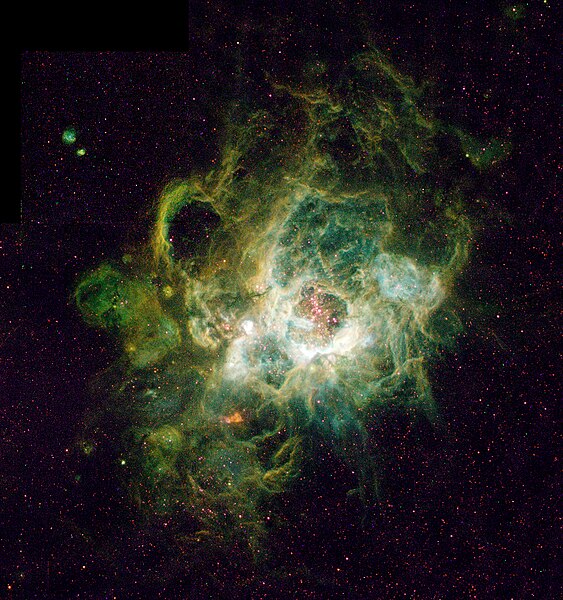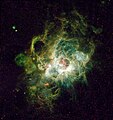File:Nursery of New Stars - GPN-2000-000972.jpg

Size of this preview: 563 × 600 pixels. Other resolutions: 225 × 240 pixels | 450 × 480 pixels | 721 × 768 pixels | 1,127 × 1,201 pixels.
Original file (1,127 × 1,201 pixels, file size: 2.42 MB, MIME type: image/jpeg)
File history
Click on a date/time to view the file as it appeared at that time.
| Date/Time | Thumbnail | Dimensions | User | Comment | |
|---|---|---|---|---|---|
| current | 18:12, 8 August 2019 |  | 1,127 × 1,201 (2.42 MB) | BevinKacon | Reverted to version as of 01:11, 9 April 2009 (UTC) bad upscale by new user |
| 13:38, 3 August 2019 |  | 1,690 × 1,800 (2.84 MB) | Armin3636 | بالا بردن کیفیت | |
| 12:08, 29 July 2019 |  | 1,024 × 1,091 (1.21 MB) | Armin3636 | بارگذاری کامل پرونده | |
| 01:11, 9 April 2009 |  | 1,127 × 1,201 (2.42 MB) | BotMultichillT | {{Information |Description={{en|1=This is a Hubble Space Telescope image (right) of a vast nebula called NGC 604, which lies in the neighboring spiral galaxy M33, located 2.7 million light-years away in the constellation Triangulum. This is a site where |
File usage
The following pages on the English Wikipedia use this file (pages on other projects are not listed):
- H II region
- Hydrogen
- List of largest known nebulae
- Nebula
- Open cluster
- Triangulum Galaxy
- Wide Field and Planetary Camera 2
- User:07 Matthew
- User:Adam Zábranský
- User:Adonis Laerte Mezzano/Books/Nebulae
- User:Alexysun/sandbox
- User:Alvations
- User:AnemoneProjectors/Userpage/Userboxes/More
- User:AngelLeVyette
- User:AntL/Userboxes
- User:Anticipation of a New Lover's Arrival, The/Galleries/Awards
- User:Armbrust/Userboxes - Television
- User:Ashill/Stellar evolution
- User:Bivariate-correlator
- User:Bmay1310
- User:Bstewart89
- User:CBJVS
- User:CPUKiller
- User:ChanceHenrik
- User:Creativity97
- User:Crumbworks
- User:Da-drumer
- User:Djdannyp
- User:Dronebogus/Basement
- User:Dsilwal
- User:Eliahna
- User:FastCube
- User:Flipwared
- User:Fluence/(002) User The Big Bang Theory
- User:Fluence/The Big Bang Theory
- User:Guoruei
- User:Harutake
- User:Hseldon10
- User:InfoLove
- User:JFoog
- User:JackofDiamonds1
- User:JacobGroves94
- User:Jarcanist/UTS
- User:JediActor1998
- User:JeffKo427/sandbox/SCN
- User:Johnny 42
- User:Jprintup
- User:Jughellcaster
- User:KConWiki/Self-categorization
- User:Karen2205
- User:Lucazeppelin
- User:MasterWolf0928-Æthelwulf
- User:MindAndBody551
- User:MrAugustusMilverton
- User:Mr Minchin/Userboxes/User Parrallel Universe
- User:NiceGuy152/Userboxes
- User:Padibso/sandbox
- User:RTSthestardust/interests
- User:Rattakorn c
- User:Rest in pieces
- User:RightCowLeftCoast/interest
- User:Ryag
- User:SambalBij
- User:SashimifanSF650
- User:Sentōkisei/Boxful
- User:SpicyChallenger
- User:Tehblooguy
- User:Tony Sidaway/old userpage
- User:Ultimate Roadgeek
- User:UserboxMaker35/Userbox Gallery
- User:UserboxMaker35/Userbox Gallery-Like Hydrogen
- User:Vellayappan
- User:Xonqnopp
- User:Zzarch
- User talk:Bivariate-correlator
- Wikipedia:Featured picture candidates/April-2005
- Wikipedia:Featured picture candidates/Image:Triangulum.nebula.full.jpg
- Wikipedia:Featured picture candidates/March-2004
- Wikipedia:Featured picture candidates/September-2006
- Wikipedia:Featured picture candidates/Triangulum.nebula.arp.750pix
- Wikipedia:Today's featured article/February 2, 2005
- Wikipedia:Today's featured article/February 2005
- Wikipedia:Today's featured article/July 2005
- Wikipedia:Today's featured article/July 29, 2005
- Wikipedia:Userboxes/Television/Shows/Comedy
- Portal:Astronomy/Featured/February 2006
- Portal:Astronomy/Picture/10 May 2005
- Portal:Astronomy/Picture/15 August 2005
- Portal:Astronomy/Picture/August 2005
- Portal:Astronomy/Picture/May 2005
- Portal:Astronomy/Picture/Week 46 2005
- Portal:Physics/2006 Selected articles
Global file usage
The following other wikis use this file:
- Usage on af.wikipedia.org
- Usage on anp.wikipedia.org
- Usage on an.wikipedia.org
- Usage on ar.wikipedia.org
- Usage on arz.wikipedia.org
- Usage on ast.wikipedia.org
- Usage on az.wikipedia.org
- Usage on ba.wikipedia.org
- Usage on be.wikipedia.org
- Usage on bg.wikipedia.org
- Usage on bn.wikipedia.org
- Usage on bs.wikipedia.org
- Usage on ca.wikipedia.org
- Usage on ceb.wikipedia.org
- Usage on ce.wikipedia.org
- Usage on cs.wikipedia.org
- Usage on da.wikipedia.org
- Usage on de.wikipedia.org
- Usage on de.wikibooks.org
- Usage on diq.wikipedia.org
- Usage on el.wikipedia.org
View more global usage of this file.

